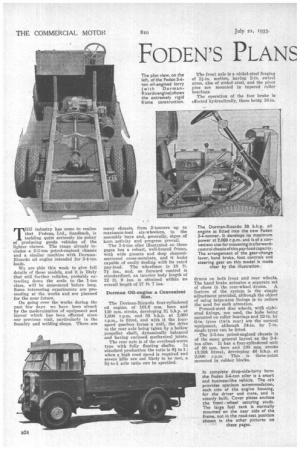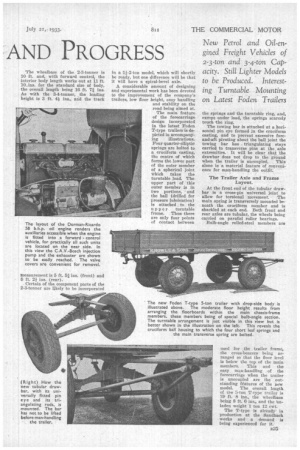FODEN'S PLANS AND PROGRESS
Page 38

Page 39

If you've noticed an error in this article please click here to report it so we can fix it.
New Petrol and Oil-engined Freight Vehicles of 2-3-ton and 3-4-ton Capacity. Still Lighter Models to be Produced. Interesting Turntable Mounting on Latest Foden Trailers TT-1 1.; industry has come to realize that Podens, Ltd., Sandbaeh, is tackling quite seriously its policy of producing goods vehicles of the lighter classes. The range already includes a 2-3-ton petrol-engined chassis and a similar machine with DormanRicardo oil engine intended for 3-4-ton loads.
We are able this week to give full details of these models, and it is likely that still further vehicles, probably extending down the scale to the 1-ton class, will be announced before long. Some interesting experiments are proceeding at the works and are planned for the near future. On going over the works during the past few days we have been struck by the modernization of equipment and layout which has been effected since our previous visit, particularly in the foundry and welding shops. There are many chassis, from 2-tortners up to maximum-load six-wheelers, in the assembly. bays and, generally, signs of keen activity and progress prevail. The 3-4-ton oiler illustrated on these pages has a robust, well-braced frame, with wide gussets and deep channelsectioned cross-members, and it looks capable of easily dealing with its rated pay-load. The wheelbase is 10 ft. 71 ins., and, as forward control is standardized, an interior body length of 12 ft. 9 ins. is obtained within an overall length of 17 ft. 7 ins.
Dorman 011-engine a Convenient Size.
The Dorman-Ricardo four-cylindered oil engine, of 101.6 ram. bore and 130 mm. stroke, developing 31 b.h.p. at 1,000 r.p.m. and 58 b.h.p. at 2,000 r.p.m., is fitted, and with it the fourspeed gearbox forms a unit, the drive to the rear axle being taken by a hollow propeller shaft, dynamically balanced and having enclosed mechanical joints. The rear axle is of the overhead-worm type with fully floating shafts. In standard production the ratio is to 1; when a high road speed is required and severe hills are not likely to be met, a 5i-to-1 axle ratio can be specified.
The front axle is a nickel-steel forging of 2k-in section, having 2-in, swivel arms, also of nickel steel, and the pivot pins are mounted in tapered roller bearings.
The operation of the foot brake is effected hydraulically, there beiug 16-in.
drums on both front and rear wheels. The hand brake actuates a separate set of shoes in the rear-wheel drums. A, feature of the system is the simple adjustment provided, although the object of using large-area linings is to reduce the need for such attention. Pressed-steel disc wheels, with eightstud fixings, are used, the hubs being mounted on roller bearings and 32-in. by 6-in. tyres (twin rear) are the normal equipment, although 34-in. by 7-in. single tyres can be fitted.
The 2-3-ton petrol-engined chassis is of the same general layout as the 3-4ton oiler. It has a four-eylindered unit of 90 mm. bore and 130 mm. stroke (3.308 litres), developing 46 b.h.p. at 2,000 r.p.m. This is three-point mounted in rubber blocks. The wheelbase of the 2-3-tormer is 10 ft. and, with forward control, the interior body length works out at 11 ft. 10-ins, for the standard size of body, the overall length being 16 ft. 71 ins. As with the 3-4-tonner, the loading height is 3 ft. 41 ins., and the track measurement is 5 ft. 51 ins. (front) and 6 ft. 21ins. (rear).
Certain of the component parts of the 2-3-tonner are likely to be incorporated in a li-24on model, which will shortly be ready, but one difference will be that it will have a spiral-bevel axle.
A considerable amount of designing and experimental work has been devoted to the improvement of the company's trailers, low floor height, easy handling and stability on the road being aimed at.
The main feature of the forecarriage design incorporated in the latest Foden T-type trailers is depicted iu accompany ing illustrations. Four quarter-elliptic springs are bolted to a cruciform casting, the centre of which forms the lower part of the outer member of a spherical joint which takes the turntable load. The upper part of this outer member is in two portions, and the ball (drilled for pressure lubrication) is attached to the upper turntable frame. Thus there are only four points of contact between the springs and the turntable ring, and, except under load, the springs scarcely touch the ring.
The towing bar is attached at a horizontal pin eye formed in the cruciform casting, and to prevent excessive foreand-aft pivoting about the ball joint the towing bar has triangulating stays carried to transverse pins at the axle extremities. It will be clear that the drawbar does not drop to the ground when the trailer is uncoupled. This alone is a material feature of convenience for man-handling the outfit.
The Trailer Axle and Frame Layout.
At the front end of the tubular drawbar is a cross-pin universal joint to allow for torsional movement. The main spring is transversely mounted beneath the cruciform member and is shackled at each end. Both front and rear axles are tubular, the wheels being carried on parallel roller bearings.
Bulb-angle rolled-steel members are
used for the trailer frame, the cross-bearers being arranged so that the floor level is below the top of the main members. This and the easy man-handling of the forecarriage when the trailer is uncoupled are the outstanding features of the new modeL The overall length of the 5-ton T-type trailer is 19 ft. 8 ins., the wheelbase being 8 ft. 6 ins., and the Unladen weight 1 ton 12 cwt.
The T-type is already, in production at the Sandbach works and a demand is being experienced for it.




























































































